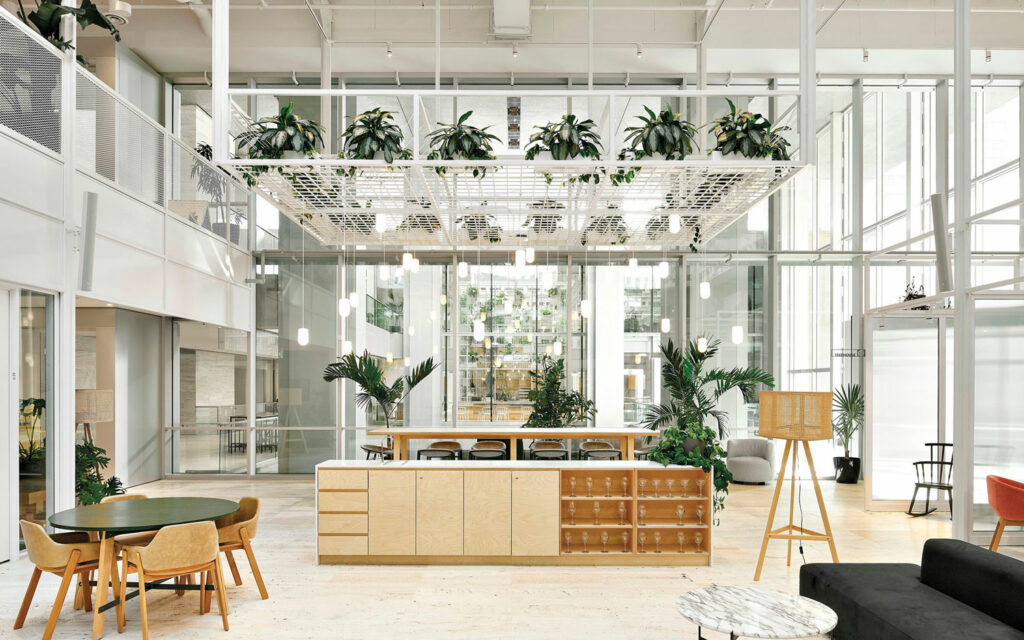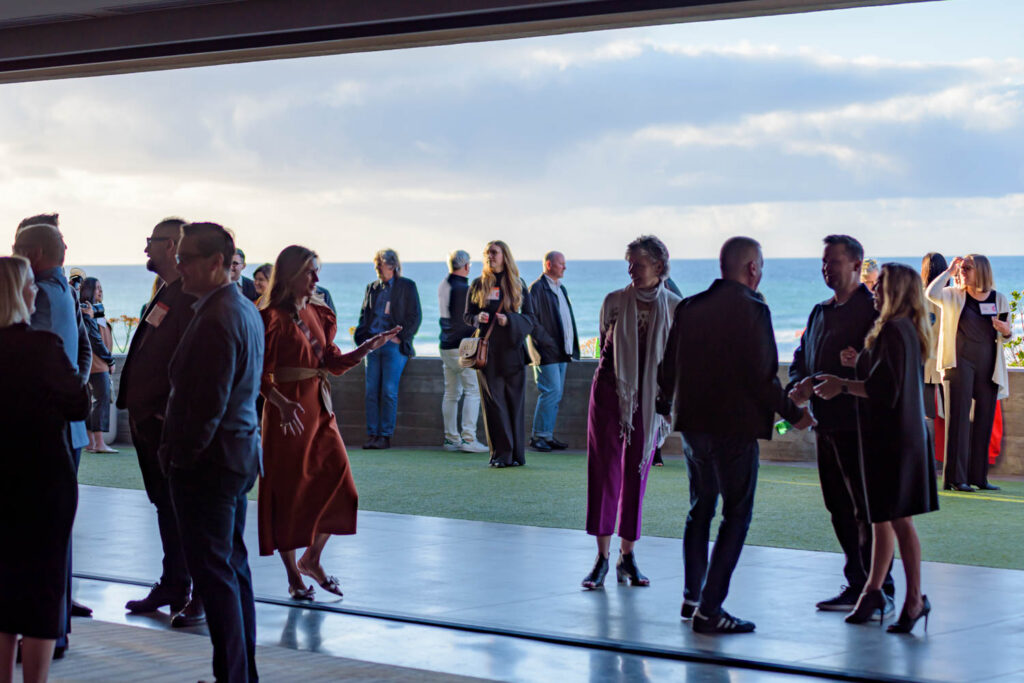
10 Questions With… Robert Remer of Opiary
Founding principal of Brooklyn-based studio Opiary, Robert Remer, views design through a unique lens. His award-winning concrete planters, luminaires, and settees all stem from the easily uttered yet rarely fully investigated proposition of reconciling humans and nature. As he says, biophilia, or more aptly termed bio-awareness, constitutes much more than just bringing greenery inside. It’s also about crafting objects that invoke our planet’s most fundamental principles; facilitating this process of reconnection is as much an explicitly aesthetic task as it is an implicitly emotional one.
A team of skilled craftspeople help the trained architect and emphatic multi-disciplinarian realize a distilled yet diverse suite of products—the Drillium chaise and modular Spolia planter system among them—based on direct orders. It’s an artisanal business model that provides Remer with the time and space to also imagine custom indoor/outdoor installations for a wide range of customers. Whether developing a stem-like floor lamp or a carefully-oriented walking path, the designer looks to champion the essential transcendence of geometry, evolution, and materiality.
Robert Remer on the Importance of Bio-Awareness, and More

Interior Design: What led you to study architecture?
Robert Remer: I have always had a foot in two worlds. Though I was raised in the rural spaces surrounding the city, I’ve also somehow been based in New York City. Playing outside in the dirt and in the woods was hugely impactful on me as a child. I spent a lot of unstructured time experiencing nature. But I also spent time in Greenwich Village, so I got to see the cultural aspects of 1980s New York City life—everything from the music scene and the rapid changes in the built environment. I have always loved knowing both worlds and mixing one with the other. It’s what inspired me to study architecture.
ID: How did training with Alice Aycock at Yale University inspire you to eventually transition into material experimentation, sculpture, and product development?
RR: Alice had a subtle way of fostering the exploration and interrogation of form and meaning. She introduced me to her cohort of 1960s and 70s-era artists and architects who were all incredibly influential in my development, notably Walter De Maria, Robert Smithson, and Donald Judd. Each of these talents transcended the traditional disciplinary definitions of art, architecture, craft, and design.

ID: When did you begin exploring the idea of biophilia? How do you define this term and how is this definition integral to your practice?
RR: It’s common sense today to say ‘people love nature and are attached to it’ but we do so from our place of extreme distance. As our spaces and lives become more technologically advanced and civilized, we are losing the perspective that innate force is both the source of life and its ultimate sink. It’s reduced to something pleasant we visit on the weekend. I do not think there is a way of getting away from this thinking without going back to a more natural state, which requires us to take in the dialectical quality of the relationship. This fundamental principle is what my work is all about.
Opiary is more than biophilia and attempts to be a bio-aware design company. We aim to make work that allows people to actually connect with nature. The unofficial motto is ‘no more dead objects.’ Our time poses new questions about this interaction, and it can be mapped out and experienced in the pieces my team and I develop. I have always incorporated nature in my projects, whether for sculpture or architecture, largely because of the demands it makes on the viewer or owner. It’s not just a frozen symbol but rather, a system in which there is constant curation and attention to singular moments and particular conditions.

ID: What is the story behind the establishment of Opiary?
RR: Opiary was founded in 2012 as a platform that could encompass the production and dissemination of the forms I was already creating. The term Opiary derives from the Latin opus arium or a “place for work.” It has a double meaning as my nickname growing up was Opie and it signified the place you can always find me.
ID: How has the studio evolved to encompass both products and projects over time?
RR: My team and I have always focused on making custom work. It started with sculpture and has since evolved to encompass furniture, lighting, and architectural finishes. We also provide clients with design services on how to incorporate a creative green layer in their projects.
ID: What is the significance of having set up shop and developed your career in Brooklyn?
RR: Move to New York City and it will change your life if you can figure out how to dance with the rhythm of the place, and do it as soon as possible because it only gets more difficult. I say this to every young person who has even the slightest inclination to try living here. That said, spending time outside of the city developing your vision is vital. Experiencing both the urban and the rural seems to be a theme in my life. I spent a lot of time in a 1918 uninsulated beach cottage—basically a wooden tent—in the Cape Cod dunes very close to nature as a counterpoint to my life in the city. Having both environments is critical to my creative thinking.

ID: How has your process of casting concrete and other material been refined over time, resulting in planters, furnishings, and custom installations?
RR: Concrete has been my chosen medium ever since I started working. It’s ubiquitous and easy to get your hands on as a young talent. I loved how it can be used anywhere, and as someone who has always been interested in breaking down the barriers between indoors and out, it’s perfect. Over the years the studio has expanded and refined how we use this material, giving us a wide spectrum of expressions. We can get super high-end finishes on pieces and also know they will stand up to the elements relatively well.
ID: Looking at your product range, how is the process behind the Drillium design different than the Spolia system?
RR: At Opiary we think in terms of form first and content second. For example, if we need a chair, it’s a form that holds a seated body. It needs to incorporate ergonomics and material science. And then there are some rules for how we design. For instance, materials need to be used essentially. If you can make the same form in wood or metal more easily, don’t make it in concrete. Also avoid all superfluous details. When the form takes shape, let it be for a function, such as to form a vessel wall, in constant contact with that which it retains, whether that be soil for plants or upholstery for cushioning. The Drillium was specifically inspired by bird bones, aircraft construction, and 1970s steel racing bicycles.
Spolia also starts with a form, a block for a wall, stackable rectilinear planter, and the same rules apply. Keep content essential, minimal, effortless, and provide room for free expression within the boundaries. It started almost as a game, eventually condensing into furniture and architecture. The name and concept for Spolia was inspired by the human habit of recycling architectural elements from past civilizations. Its name is the Latin root of our word “spoils” (of war). In everything, there’s always a place to experience nature.
ID: How much does experimentation and being able to scale your explorations factor into your day-to-day?
RR: Experimentation, close observation, and memorization are of course core disciplines of any practice and remain critical to that of my team and I as well.
ID: Could you take us through some of your most recent installation projects?
RR: We work closely with our clients to offer them highly customized, boutique pieces. Projects go through conceptualization, design development, production, and installation. We offer help to our clients at all stages, making the process as effortless as possible. For a modern residence in Greenwich [Connecticut] with a large roof terrace, we recently created a stroll garden meandering between different rooms. This space was formed by groupings of our planters, which also were adapted to grow on the walls like barnacles on the bottom of a ship, and a 40-foot Spolia wall that encloses a space with a fireplace, bench, and custom Spolia sideboards planted with a bamboo hedge. All of these elements were custom-designed and made in our studio for this space. It’s magical to see it all come together.

read more
DesignWire
New & Noteworthy: 4 Artful Updates
The sizzle of mid-summer isn’t slowing down the design community. Here is a look at the latest batch of art installations and venue openings, plus the glassmaking technique behind the 2019 Tour de France trophy. &n…
Projects
This Montreal Office Takes Biophilic Design to the Next Level
Sid Lee Architecture transforms part of the Place Ville Marie in downtown Montreal into a living, breathing office based on I. M. Pei’s original grid-based design.
DesignWire
10 Questions With… Furniture Artist Caleb Ferris
Furniture artist Caleb Ferris creates tongue-in-cheek designs that bring a sense of humor to the world of contemporary collectible design.
recent stories
DesignWire
Top Product Picks from the 2024 Kitchen & Bath Industry Show
Check out the sizzling, must-see products that have graced the show floor of NKBA’s KBIS 2024, from Barbie pink faucets to sleek gas cooktop ranges.
DesignWire
10 Questions With… Architect and Designer, Victoria Yakusha
Ukrainian architect, designer and artist Victoria Yakusha sheds light on her overall practice and the ongoing challenge of the war in Ukraine.
DesignWire
Giants and Rising Talent Attendees Explore How Science Shapes Design
What type of environment optimizes cognitive function? A neuroscientist explores this question and more during Interior Design’s Giants and Rising Talent event.





